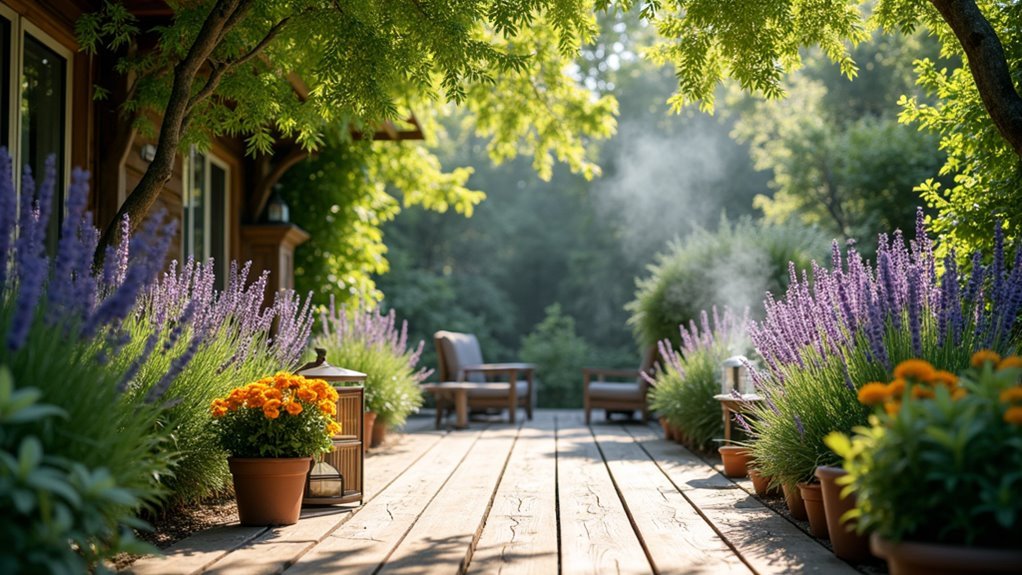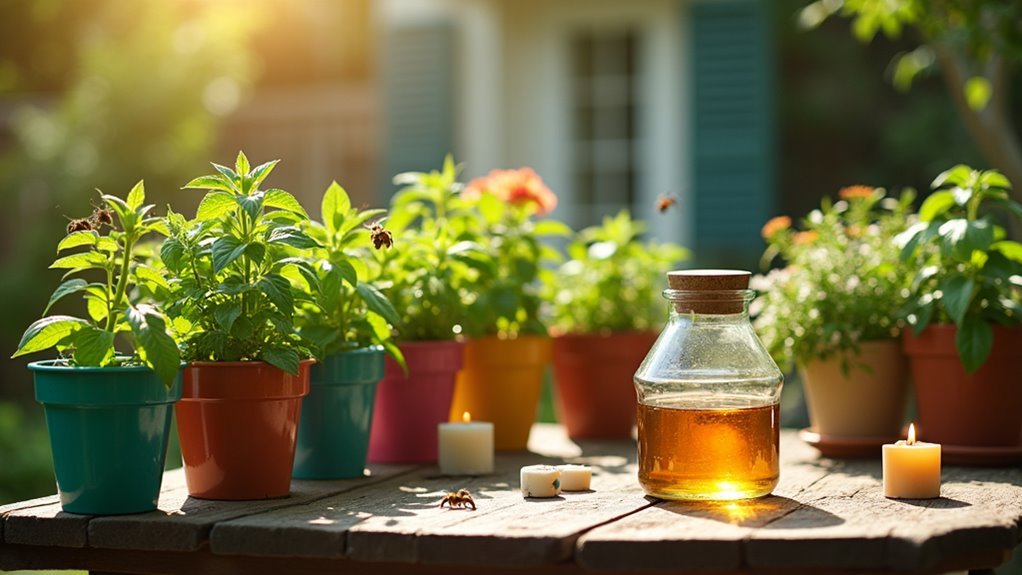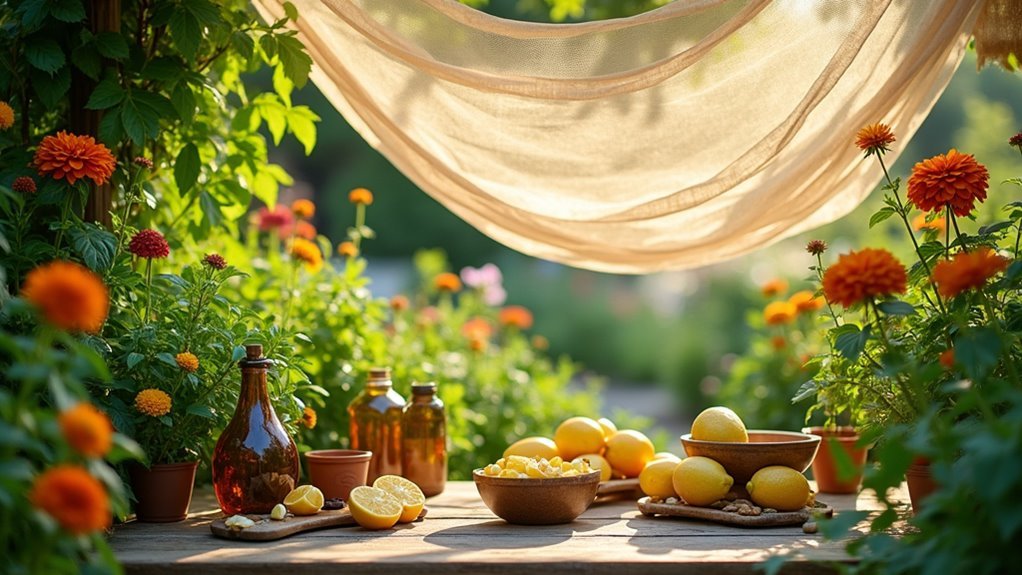You can quickly repel flies by strategically placing aromatic herbs like basil, lavender, and mint near windows, doors, and seating areas where their essential oils create natural barriers. Position moving water features away from dining spaces to prevent fly breeding while designing wind corridors with tall plants to disrupt their flight patterns. Regularly crush herb leaves to release stronger scents, and combine multiple varieties for amplified effects that’ll reveal even more powerful deterrent strategies.
Strategic Plant Placement for Maximum Fly Deterrence

When planning your garden’s fly defense system, you’ll want to focus on creating strategic barriers at key entry points around your home.
Position fly repellent plants like basil, lavender, and mint near windows and doors to block flies from entering. Strategic plant placement becomes even more effective when you group several varieties together, as their combined fragrances amplify the repelling effects.
Use pots for catnip and lemon balm along pathways and doorways, making them easily movable for maximum coverage.
Plant marigolds and rosemary around outdoor seating areas to deter flies while adding visual appeal.
Remember to regularly crush or rub leaves of basil and mint to release their natural oils, enhancing their fly-repelling properties and strengthening your garden’s defensive barrier.
Aromatic Herbs That Naturally Repel Flying Insects
You’ll find that aromatic herbs work as natural fly repellents through their essential oil release mechanisms, which create invisible barriers that flying insects actively avoid.
When you plant these herbs strategically around your garden’s high-traffic areas, you’re positioning their natural defenses where they’ll have maximum impact against unwanted pests.
The key lies in understanding how these plants distribute their protective compounds and placing them where air circulation can carry their deterrent properties throughout your outdoor spaces.
Essential Oil Release Mechanisms
While flies rely heavily on their sense of smell to navigate and locate food sources, aromatic herbs turn this natural ability against them by releasing potent essential oils that create an unwelcoming environment.
These volatile compounds naturally emit from plant tissues, but you can enhance their effectiveness through strategic activation methods.
To maximize essential oil release and repel flies more effectively, consider these techniques:
- Crush fresh leaves between your fingers before placing them near entry points or outdoor seating areas.
- Create water-based sprays by mixing eucalyptus or lemongrass oils with water for targeted application.
- Plant dual-purpose herbs like rosemary and sage that release compounds while providing culinary benefits.
Citronellal from lemon balm and other aromatic compounds work continuously, but physical activation greatly boosts their fly-deterrent properties.
Strategic Garden Placement Tips
Beyond simply growing fly-repelling herbs, their placement throughout your garden determines how effectively they’ll protect your outdoor spaces.
Position plants that repel flies like basil, mint, and lavender near doorways and windows to create natural barriers preventing flies from entering your home.
Place rosemary and sage around outdoor seating areas where you’ll entertain guests.
Use pots for mobile herbs like catnip and pennyroyal, positioning them along garden paths and entry points for easy relocation.
Incorporate marigolds and tansy within existing flower beds, as their strong scents scientifically repel flying pests while maintaining visual appeal.
Group several fly-repelling varieties together in concentrated areas—these strategic garden placement tips maximize effectiveness since combined aromas create more potent deterrents.
Creating Fragrant Barriers Around Outdoor Living Spaces

When designing outdoor living spaces, strategic placement of aromatic plants creates natural barriers that keep flies at bay while enhancing your garden’s sensory appeal.
You’ll want to incorporate fly-repellent varieties like basil, lavender, and rosemary around seating areas to establish effective fragrant perimeters. These plants that repel mosquitoes also excel at repelling flies through their potent essential oils.
Consider these strategic placement techniques:
- Position mint and lemon balm near entry points and doorways to intercept flies before they reach your space.
- Create fragrant hedges using sage and rosemary combinations that serve dual purposes as barriers and culinary herbs.
- Install marigold borders around patios and decks for scientifically-proven insect deterrence plus vibrant color.
Remember to regularly crush aromatic leaves to release maximum essential oils for enhanced fly-repelling effectiveness.
Water Feature Design to Discourage Fly Breeding
You’ll find that incorporating moving water features like fountains or waterfalls creates an environment that naturally discourages fly breeding since these pests require stagnant water to lay their eggs.
Strategic placement of these features away from dining areas and compost zones reduces fly attractants while the continuous water circulation prevents the still conditions flies seek.
Smart positioning combined with proper aeration systems transforms your water features from potential breeding grounds into effective fly deterrents.
Moving Water Benefits
Moving water features transform your garden into a natural fly-repelling zone while adding beautiful visual and auditory elements to your outdoor space. The continuous motion disrupts flies’ breeding cycles, forcing them to seek stagnant water elsewhere for egg-laying.
Your moving water installation provides multiple fly control advantages:
- Creates airflow patterns that make it difficult for flies to land and settle
- Attracts natural predators like birds and dragonflies that consume adult flies
- Eliminates breeding sites by preventing water stagnation where larvae develop
Position fountains or waterfalls near seating areas to maximize their deterrent effect. The sound masks food odors that attract flies while improving air circulation.
However, you’ll need consistent maintenance to prevent blockages that could create stagnant pools, potentially reversing the fly control benefits.
Fountain Placement Strategies
Strategic fountain placement amplifies the fly-deterrent benefits of moving water throughout your garden space.
Position fountains in areas where flies typically congregate, such as near dining areas, garbage bins, or compost areas. Create multiple water zones by installing cascading waterfalls or splashing features that generate continuous movement and sound disturbance.
Surround your fountains with fly-repellent plants like lavender or mint to create a synergistic barrier effect.
Place water features where they’ll catch prevailing breezes, enhancing the disruption of still air that flies prefer for breeding and resting.
Maintain proper fountain functionality by ensuring water keeps moving constantly.
Clean regularly to prevent algae growth and debris accumulation that could transform your fly deterrent into a breeding ground.
Container Gardening for Portable Pest Control

When you’re dealing with flies around your home, container gardening offers the perfect solution for creating a mobile defense system.
You can strategically position fly-repellent plants like basil, mint, and lavender near doors and windows where they’ll be most effective. Pots give you flexibility to move plants around your garden or home, adapting to seasonal changes and high-activity areas.
Here are three key advantages of container gardening for fly control:
- Strategic positioning – Place plants exactly where you need them most
- Space efficiency – Perfect for balconies, patios, and small areas
- Enhanced potency – Easy access to crush leaves and release essential oils
Grouping these plants together creates an attractive, fragrant barrier that confuses and helps repel flies while maintaining visual appeal.
Companion Planting Techniques for Enhanced Protection
Beyond simply placing individual plants in strategic locations, you’ll discover that companion planting creates synergistic relationships that amplify your garden’s natural fly-fighting power.
By strategically pairing fly-repellent plants like basil with tomatoes, you’ll enhance both crop flavor and pest protection simultaneously. Integrate strong-scented herbs such as rosemary and sage throughout your vegetable beds to create an aromatic barrier that deters flies while promoting plant growth.
Strategic herb placement creates aromatic barriers that simultaneously enhance crop flavors while naturally deterring flies from vegetable gardens.
Plant marigolds near vegetables to repel flies and attract beneficial pollinators and predatory insects that’ll control pest populations naturally.
Don’t forget to regularly rotate companion plants like catnip or pennyroyal across different garden sections. This rotation disrupts pest life cycles and maintains your natural repellent system’s effectiveness throughout the growing season.
Garden Layout Strategies to Minimize Fly Attractants
Although companion planting provides excellent protection through plant relationships, you’ll achieve even greater fly control by thoughtfully designing your garden’s physical layout to eliminate attractants and maximize natural deterrents.
Strategic positioning forms the foundation of effective fly management. Place lavender and mint near entrances and seating areas to create natural barriers. Install raised beds for herbs like basil and rosemary, making maintenance simpler while enhancing visual appeal.
Key layout strategies include:
- Relocate attractants – Position compost bins and garbage areas far from gathering spots.
- Create natural borders – Use pathways for planting it around with marigolds and tansy.
- Improve air circulation – Design open spaces and eliminate stagnant water features.
These thoughtful placement decisions will keep flies away while maintaining your garden’s beauty and functionality.
Seasonal Maintenance for Year-Round Fly Management
While strategic garden layout creates the foundation for fly control, maintaining your fly-repellent plants throughout the seasons guarantees they’ll continue protecting your outdoor spaces year-round.
Regular pruning enhances natural oils in basil, mint, and lavender, maximizing their deterrent fragrances. You’ll want to implement seasonal planting strategies—introduce marigolds in spring and rosemary in fall for diverse fly barriers.
For indoor fly-repellent plants, adjust placement seasonally to guarantee proper air circulation and sunlight exposure. Conduct thorough seasonal clean-ups by removing organic debris that attracts flies while checking plant health.
Monitor and rotate potted plants around seating areas based on seasonal changes. This strategic movement maximizes repelling effects during peak fly activity months.
Consistent seasonal maintenance keeps your natural fly defense system working effectively year-round.
Combining Physical and Natural Deterrent Methods
When you combine natural fly-repellent plants with physical barriers, you’ll create a thorough defense system that tackles fly problems from multiple angles.
This dual approach maximizes your garden’s ability to prevent flies from establishing themselves in your outdoor space.
Strategic placement of basil, lavender, and mint around mesh screens and garden netting creates overlapping protection zones.
The plants emit natural repelling scents while physical barriers block direct access to your crops.
Here are three effective combination strategies:
- Position potted fly-repellent plants near mesh-covered growing areas for concentrated deterrence
- Apply essential oils like eucalyptus to physical barriers for enhanced repelling power
- Surround compost bins with lavender while maintaining proper covers to minimize attractants
This integrated approach guarantees flies encounter multiple deterrents simultaneously, greatly reducing their presence in your garden.
Air Circulation Design Elements for Fly Prevention
You can dramatically reduce fly populations by creating strategic airflow patterns throughout your garden space.
Position fans near seating areas to disrupt fly movement, design natural wind corridors between plantings, and incorporate water features that generate consistent air circulation.
These elements work together to eliminate the still air conditions that flies need for comfortable breeding and navigation.
Strategic Fan Placement
Strategic fan placement serves as one of the most effective mechanical solutions for creating fly-free outdoor spaces.
You’ll want to position fans near dining areas and entry points where flies typically congregate. The steady airflow disrupts their flight patterns, making it nearly impossible for them to hover and land on surfaces.
Consider these key placement strategies:
- Install oscillating fans to cover wider areas and reach multiple zones
- Position fans at entry points to create barriers that keep flies away from indoor spaces
- Place fans near food service areas to maintain consistent airflow around dining spaces
Maintain a gentle breeze setting rather than high speeds.
This strategic fan placement effectively keeps flies away while ensuring guest comfort and seamlessly integrating into your garden’s aesthetic design.
Natural Wind Corridors
While fans provide excellent mechanical air movement, you can amplify their effectiveness by designing natural wind corridors that harness your garden’s existing airflow patterns.
Position tall plants and hedges strategically to direct breezes through your space, particularly around seating and dining areas where flies congregate. These windbreaks create continuous airflow that disrupts fly breeding and resting patterns, as flies prefer still air environments.
Install water features like fountains to increase humidity and airflow naturally.
Consider plants that release natural oils into the breeze for added repellent effects.
Design open pathways and eliminate clutter to allow winds to flow freely throughout your garden. This strategic layout prevents flies from settling in specific zones, helping you create a fly-free outdoor environment that’s both functional and beautiful.
Water Feature Airflow
Moving water features like fountains, waterfalls, and bubbling streams create powerful air circulation that naturally disrupts fly activity throughout your garden.
The constant movement and sound of running water generates airflow that flies actively avoid, as they prefer calm, still environments for resting and feeding.
Position your water feature strategically near seating and dining areas to maximize fly deterrence where you need it most.
Here’s how to optimize effectiveness:
- Maintain clean, flowing water to prevent stagnant conditions that attract breeding flies
- Combine with fans to amplify airflow circulation throughout your outdoor space
- Choose features with multiple water streams to increase air movement coverage
The enhanced airflow from your water feature creates an inhospitable environment that keeps flies moving away from your garden sanctuary.
Integrating Carnivorous Plants Into Garden Schemes
Though carnivorous plants might seem like an unconventional choice, they’ll transform your garden into a natural fly-catching powerhouse while adding striking visual appeal.
Venus flytraps and pitcher plants effectively deter flies through their specialized trapping mechanisms, using bright colors and enticing scents as natural lures.
You’ll need to create specific growing conditions for success. Plant them in nutrient-poor, acidic soils within bog gardens or well-drained areas rich in organic matter.
Position these carnivorous plants in sunny, humid spots receiving at least 12 hours of daily sunlight. Always water with distilled or rainwater to prevent harmful mineral buildup.
Frequently Asked Questions
What Keeps Flies Away in the Garden?
You’ll keep flies away by planting aromatic herbs like basil, lavender, and mint. Add marigolds and chrysanthemums near entry points. Remove decaying matter promptly and use netting over crops for effective protection.
Do Bags of Water Keep Flies Away in Mythbusters?
You’ll find that MythBusters tested water bags for fly deterrence and busted this myth. They discovered the bags don’t effectively repel flies, confirming there’s no scientific evidence supporting this popular belief.
What Smell Do Flies Hate the Most?
You’ll find flies hate citronellal from lemon balm most intensely. They’re also repelled by strong herbal scents like basil, mint, lavender, rosemary, and sage, which contain natural oils that confuse their senses effectively.
What Plant Repels Flies the Most?
You’ll find basil repels flies most effectively since it releases powerful natural oils when leaves are disturbed. Plant it near doorways and windows where you’ll brush against it regularly for maximum fly-deterring benefits.
In Summary
You’ll transform your outdoor space into a fly-free sanctuary by combining these strategic design elements. Don’t rely on just one method—layer aromatic herbs with proper water management, add carnivorous plants near seating areas, and guarantee adequate airflow throughout your garden. You’ll see immediate results when you implement multiple techniques together. Keep up with seasonal maintenance, and you’ll enjoy peaceful outdoor living without the constant annoyance of buzzing flies disrupting your relaxation time.





Leave a Reply